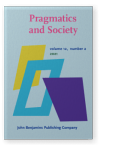Vol. 12:2 (2021) ► pp.224–242
Efficiency in shaping grammars
The case of multiple occurrences of the Chinese reflexive ziji
Hawkins (1994, 1999, 2004, 2014a) proposes a performance-grammar correspondence hypothesis, claiming that grammars can be shaped by processing systems with reference to the degree of preference in communication. Given that Hawkins’s proposal mainly highlights the role of efficiency in language comprehension, this paper demonstrates that parsing principles can also be employed to account for language production. Based on an analysis of the production mechanism behind multiple occurrences of the Chinese reflexive ziji ‘self’ in a single clause, it shows that the notion of intersubjectivity can sometimes play a significant role in sentence planning, in the sense that the Chinese reflexive assists speakers to produce an utterance in line with the principle of efficiency, which will in turn help hearers compute the intended meaning by identifying potential referents.
Article outline
- 1.Introduction
- 2.The performance-grammar correspondence hypothesis
- 3.Principles of language production
- 4.A production-based account
- 4.1A production account of multiple zijis
- 5.Conclusion
- Acknowledgements
- Notes
- Abbreviations
-
References
